Kalman Filter Based Load Monitoring in Beam Like Structures Using Fibre-Optic Strain Sensors
Abstract
1. Introduction
- (i)
- Low power loss
- (ii)
- Resistance to electromagnetic interference
- (iii)
- Low security risk
- (iv)
- Small size
- (v)
- Lightweight
- (vi)
- Easy to accommodate increasing bandwidth
- (vii)
- Resistant to harsh conditions
2. Theoretical Background
2.1. Beam Theory
2.2. Kalman Filter
3. Experimental Setup
Strain Measurements
4. Numerical Results
4.1. Need for KF
4.2. Need for RNA Tracking
5. Experimental Results
5.1. Load Monitoring
5.2. Load Monitoring under Damage Scenarios
6. Conclusions and Future Work
Author Contributions
Funding
Acknowledgments
Conflicts of Interest
References
- Majumder, M.; Gangopadhyay, T.K.; Chakraborty, A.K.; Dasgupta, K.; Bhattacharya, D.K. Fibre Bragg gratings in structural health monitoring—Present status and applications. Sens. Actuators A Phys. 2008, 147, 150–164. [Google Scholar] [CrossRef]
- Manovachirasan, A.; Suthasupradit, S.; Choi, J.H.; Kim, B.J.; Kim, K.D. The Evaluation of Axial Stress in Continuous Welded Rails via Three-Dimensional Bridge–Track Interaction. Int. J. Steel Struct. 2018, 18, 1–14. [Google Scholar] [CrossRef]
- Kouroussis, G.; Caucheteur, C.; Kinet, D.; Alexandrou, G.; Verlinden, O.; Moeyaert, V. Review of trackside monitoring solutions: From strain gages to optical fibre sensors. Sensors 2015, 15, 20115–20139. [Google Scholar] [CrossRef] [PubMed]
- Shao, L.Y.; Zhang, M.; Xie, K.; Zhang, X.; Wang, P.; Yan, L. The Longitudinal Force Measurement of CWR Tracks with Hetero-Cladding FBG Sensors. Sensors 2016, 16, 2184. [Google Scholar] [CrossRef] [PubMed]
- Wang, P.; Xie, K.; Shao, L.; Yan, L.; Xu, J.; Chen, R. Longitudinal force measurement in continuous welded rail with bi-directional FBG strain sensors. Smart Mater. Struct. 2015, 25, 015019. [Google Scholar] [CrossRef]
- Kim, N.; Yun, H.B. Noncontact mobile sensing for absolute stress in rail using photoluminescence piezospectroscopy. Struct. Health Monit. 2018, 17, 1213–1224. [Google Scholar] [CrossRef]
- Frieden, J.; Cugnoni, J.; Botsis, J.; Gmur, T.; Coric, D. High-speed internal strain measurements in composite structures under dynamic load using embedded FBG sensors. Compos. Struct. 2010, 92, 1905–1912. [Google Scholar] [CrossRef]
- Hao, J.Z.; Ong, L.C.; Gong, Y.D.; Cai, Z.H.; Ng, J.H.; Varghese, P. A temperature-independent lateral force sensor using a pair of FBGs. In Proceedings of the 2007 Microwave Conference (APMC 2007), Bangkok, Thailand, 11–14 December 2007; pp. 1–5. [Google Scholar]
- Kuang, K.S.; Cantwell, W.J.; Scully, P.J. An evaluation of a novel plastic optical fibre sensor for axial strain and bend measurements. Meas. Sci. Technol. 2002, 13, 1523. [Google Scholar] [CrossRef]
- Everall, L.; Gallon, A.; Roberts, D. Optical fibre strain sensing for practical structural load monitoring. Sens. Rev. 2000, 20, 113–119. [Google Scholar] [CrossRef]
- Suresh, R.; Tjin, S.C. Bhalla, Multi-component force measurement using embedded fiber Bragg grating. Opt. Laser Technol. 2015, 41, 431–440. [Google Scholar] [CrossRef]
- Kisala, P.; Cieszczyk, S. Method of simultaneous measurement of two direction force and temperature using FBG sensor head. Appl. Opt. 2015, 54, 2677–2687. [Google Scholar] [CrossRef]
- Ma, G.M.; Li, C.R.; Jiang, J.; Quan, J.T.; Cheng, Y.C. Design of fiber Bragg grating load sensor used in ice monitoring on overhead transmission lines. In Proceedings of the 2010 International Conference on High Voltage Engineering and Application (ICHVE), New Orleans, LA, USA, 11–14 October 2010; pp. 232–235. [Google Scholar]
- Fernando, C.; Bernier, A.; Banerjee, S.; Kahandawa, G.G.; Eppaarchchi, J. An investigation of the use of embedded FBG sensors to measure temperature and strain inside a concrete beam during the curing period and strain measurements under operational loading. Procedia Eng. 2017, 188, 393–399. [Google Scholar] [CrossRef]
- Huynh, T.C.; Kim, J.T. FOS-based prestress force monitoring and temperature effect estimation in unbonded tendons of PSC girders. J. Aerosp. Eng. 2016, 30, B4016005. [Google Scholar] [CrossRef]
- Song, X.; Zhang, Y.; Liang, D. Load Identification for a Cantilever Beam Based on Fiber Bragg Grating Sensors. Sensors 2017, 17, 1733. [Google Scholar] [CrossRef]
- Liu, J.; Sun, X.; Han, X.; Jiang, C.; Yu, D. Dynamic load identification for stochastic structures based on Gegenbauer polynomial approximation and regularization method. Mech. Syst. Signal Process. 2015, 56, 35–54. [Google Scholar] [CrossRef]
- Song, H.; Yu, K.; Li, X.; Han, J. Error estimation of load identification based on linear sensitivity analysis and interval technique. Struct. Multidiscip. Optim. 2017, 55, 423–436. [Google Scholar] [CrossRef]
- Ma, C.; Tuan, P.; Lin, D.; Liu, C. A study of an inverse method for the estimation of impulsive loads. Int. J. Syst. Sci. 1998, 29, 663–672. [Google Scholar] [CrossRef]
- Ma, C.; Ho, C. An inverse method for the estimation of input forces acting on non-linear structural systems. J. Sound Vib. 2004, 275, 953–971. [Google Scholar] [CrossRef]
- Lin, D. Input estimation for nonlinear systems. Inverse Probl. Sci. Eng. 2010, 18, 673–689. [Google Scholar] [CrossRef]
- Kim, J.; Kim, K.; Sohn, H. Autonomous dynamic displacement estimation from data fusion of acceleration and intermittent displacement measurements. Mech. Syst. Signal Process. 2014, 42, 194–205. [Google Scholar] [CrossRef]
- Casciati, F.; Casciati, S.; Faravelli, L.; Vece, M. Validation of a data-fusion based solution in view of the real-time monitoring of cable-stayed bridges. Procedia Eng. 2014, 199, 2288–2293. [Google Scholar] [CrossRef]
- Zhang, C.; Xu, Y. Structural damage identification via multi-type sensors and response reconstruction. Struct. Health Monit. 2016, 15, 715–729. [Google Scholar] [CrossRef]
- Brown, R.; Hwang, P. Introduction to Random Signals and Applied Kalman Filtering; Wiley: New York, NJ, USA, 1992; Volume 3, p. 1523. [Google Scholar]
- Anderson, B.; Moore, J. Optimal Filtering; Prentice-Hall: Upper Saddle River, NJ, USA, 2005. [Google Scholar]
- Soman, R.; Malinowski, P.; Majewska, K.; Mieloszyk, M.; Ostachowicz, W. Kalman filter based neutral axis tracking in composites under varying temperature conditions. Mech. Syst. Signal Process. 2018, 110, 485–498. [Google Scholar] [CrossRef]
- Yeager, M.; Todd, M.; Gregory, W.; Key, C. Assessment of embedded fiber Bragg gratings for structural health monitoring of composites. Struct. Health Monit. 2017, 16, 262–275. [Google Scholar] [CrossRef]
- Luyckx, G.; Voet, E.; Lammens, N.; Degrieck, J. Strain measurements of composite laminates with embedded fibre Bragg gratings: Criticism and opportunities for research. Sensors 2011, 11, 384–408. [Google Scholar] [CrossRef] [PubMed]
- Kinet, D.; Mégret, P.; Goossen, K.; Qiu, L.; Heider, D.; Caucheteur, C. Fiber Bragg grating sensors toward structural health monitoring in composite materials: Challenges and solutions. Sensors 2014, 14, 7394–7419. [Google Scholar] [CrossRef] [PubMed]
- Soman, R.; Ostachowicz, W. Kalman Filter based Neutral Axis tracking for damage detection in composites structures under changing axial loading conditions. Compos. Struct. 2018, 206, 517–525. [Google Scholar] [CrossRef]
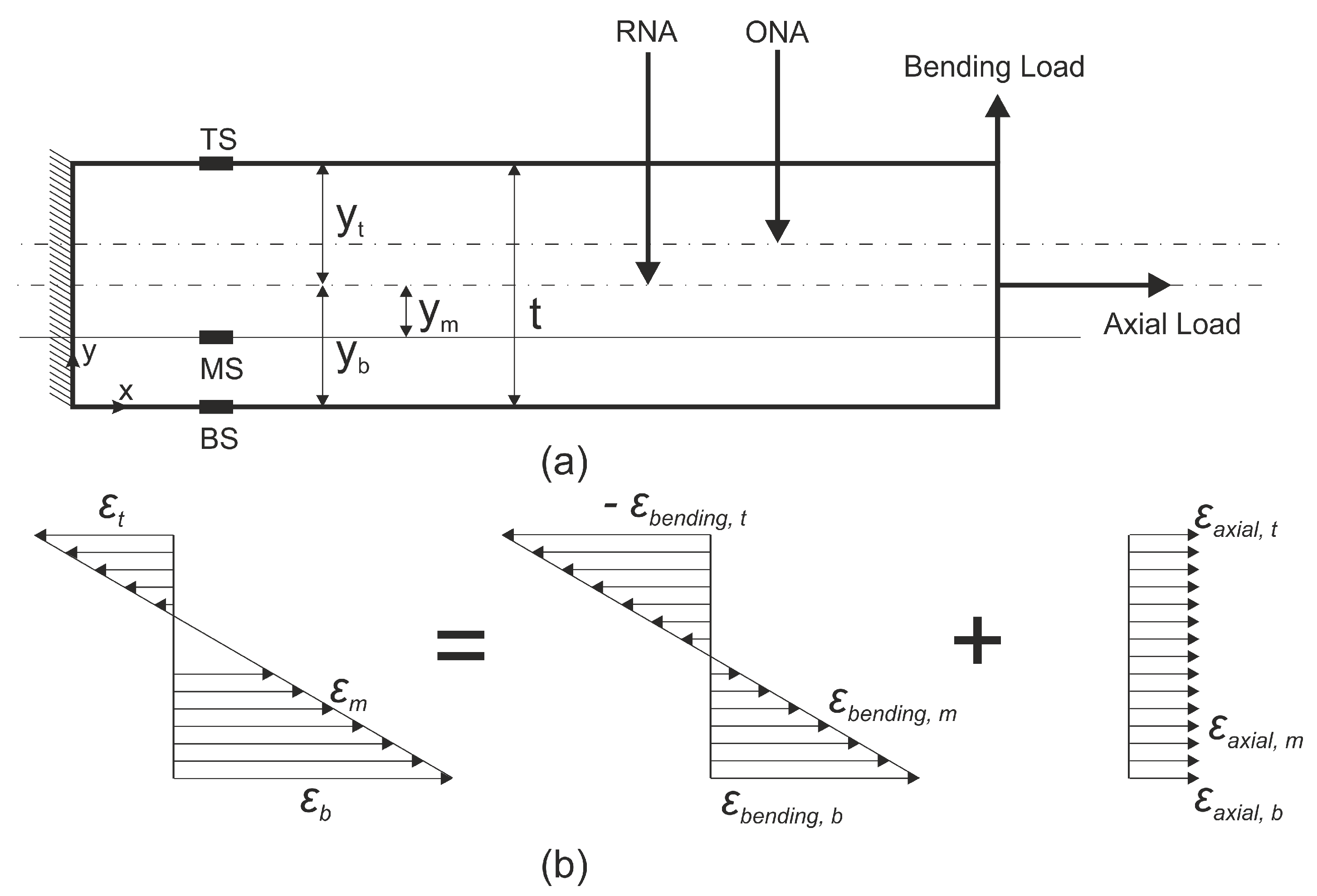
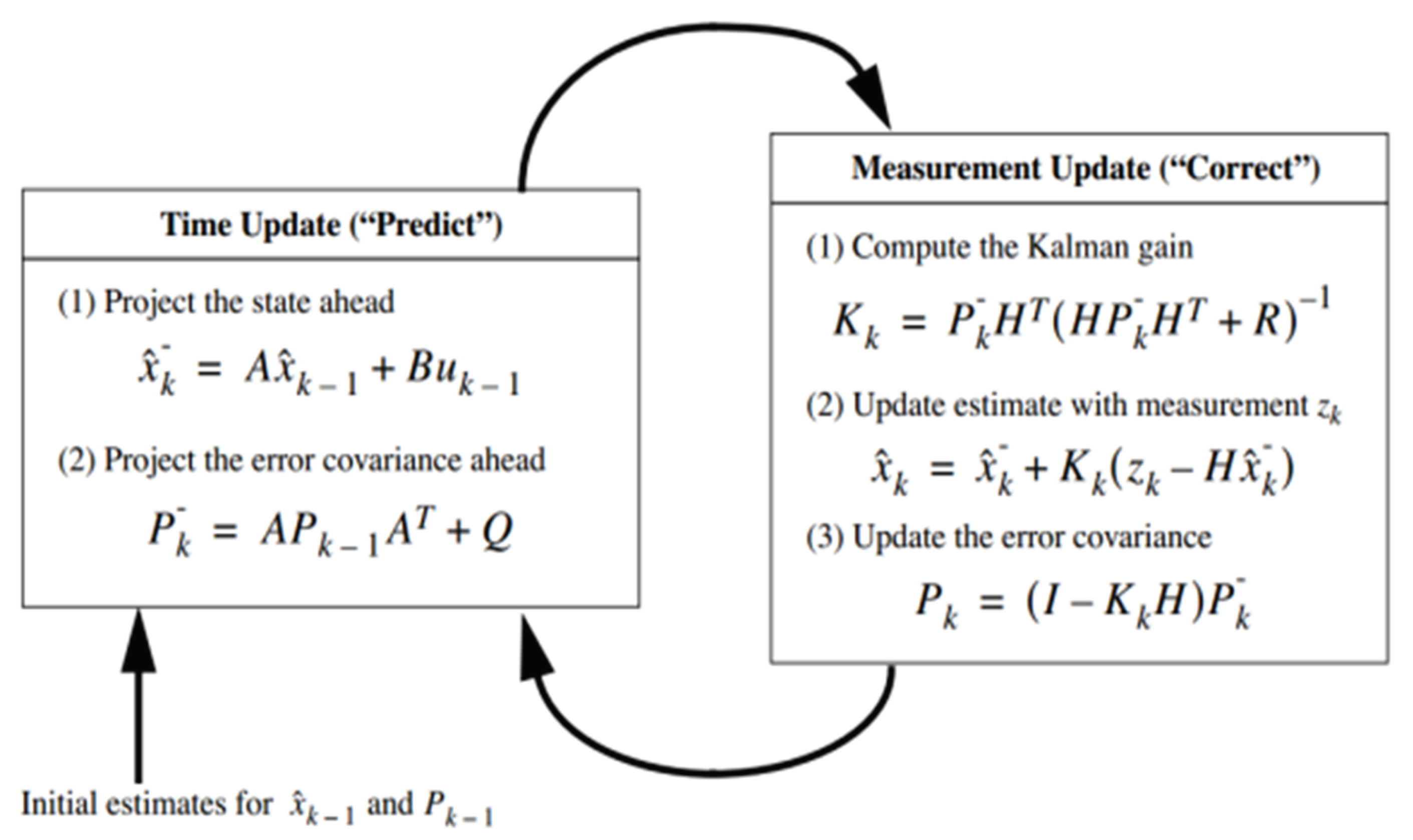

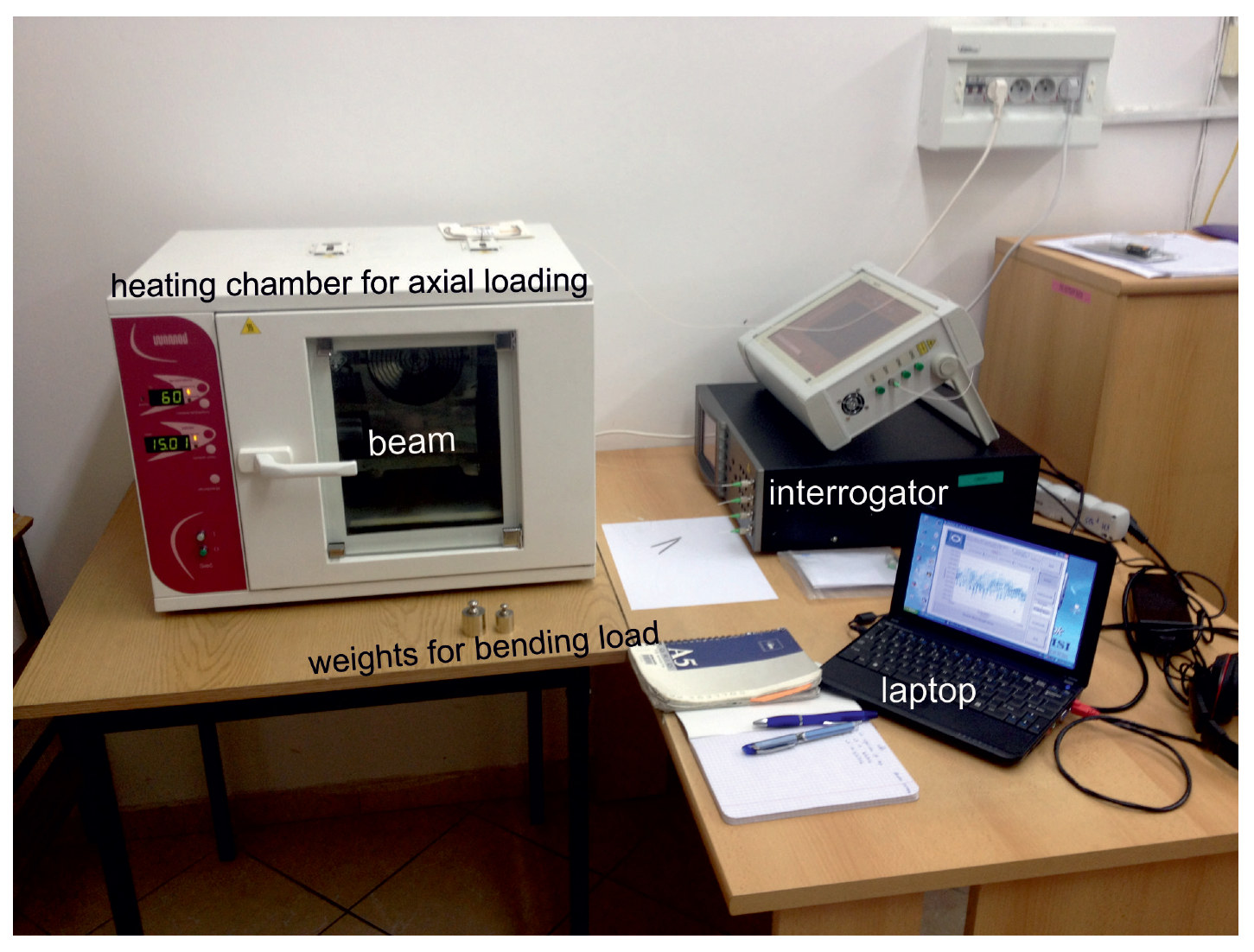

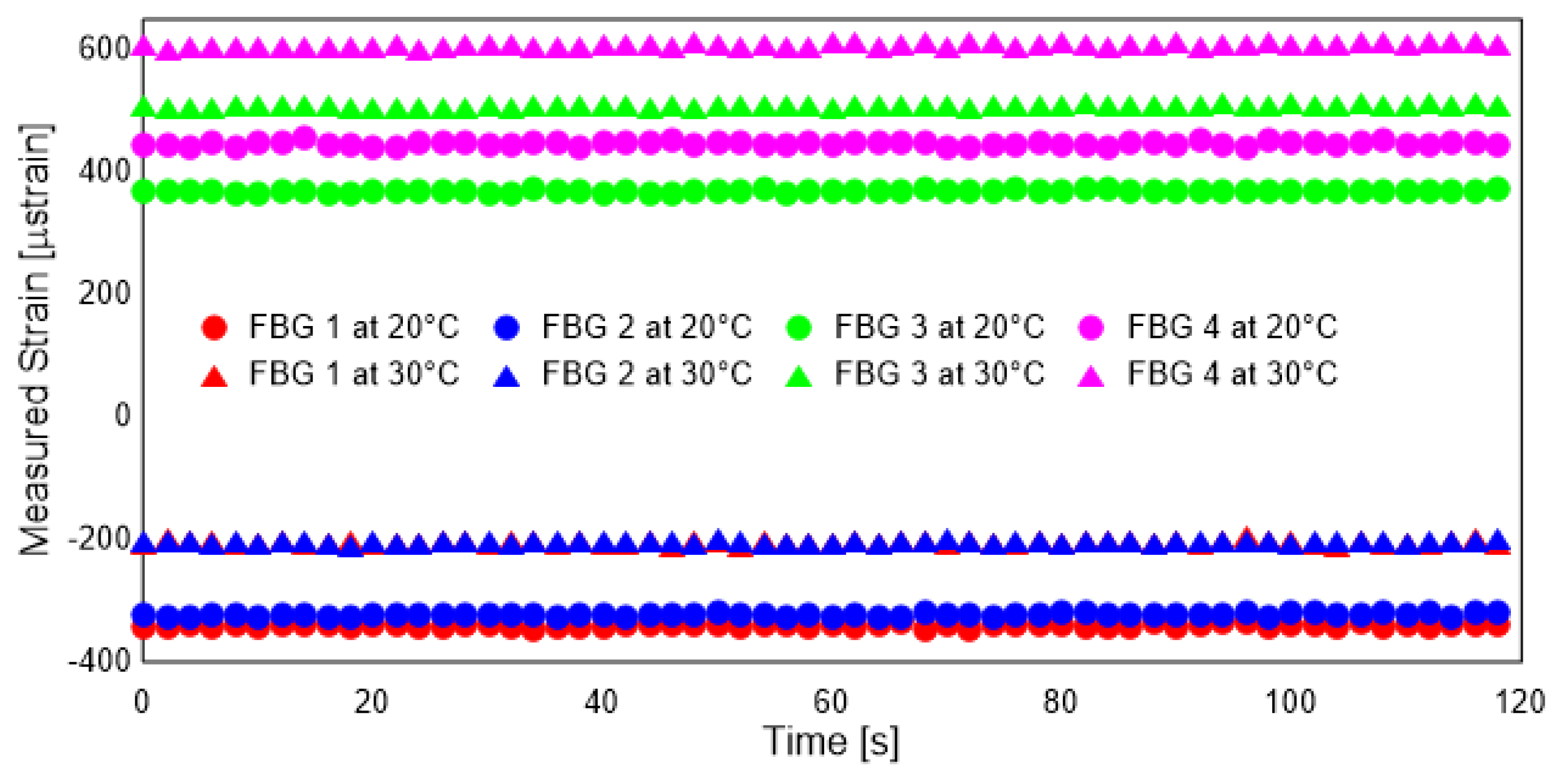
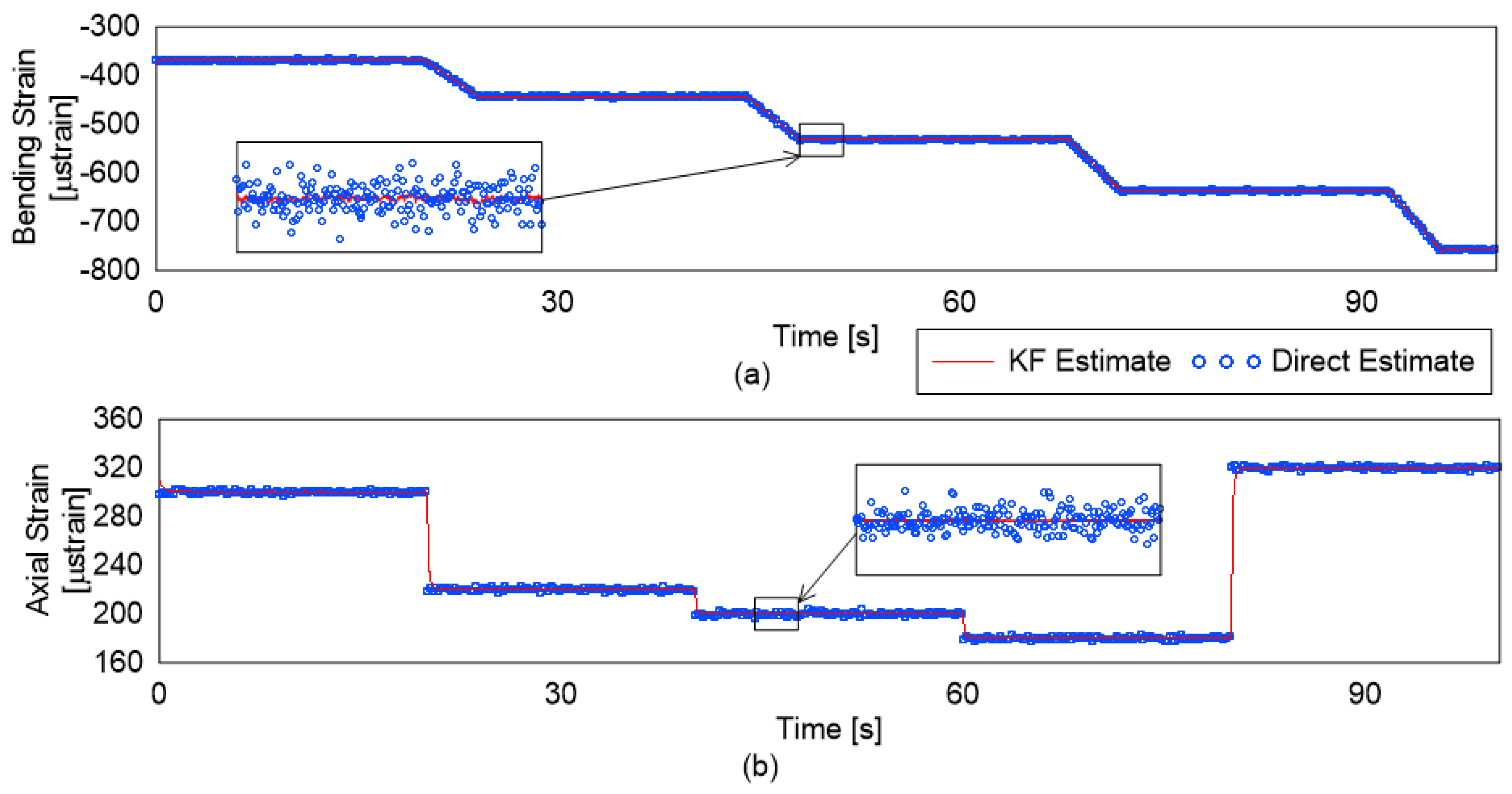
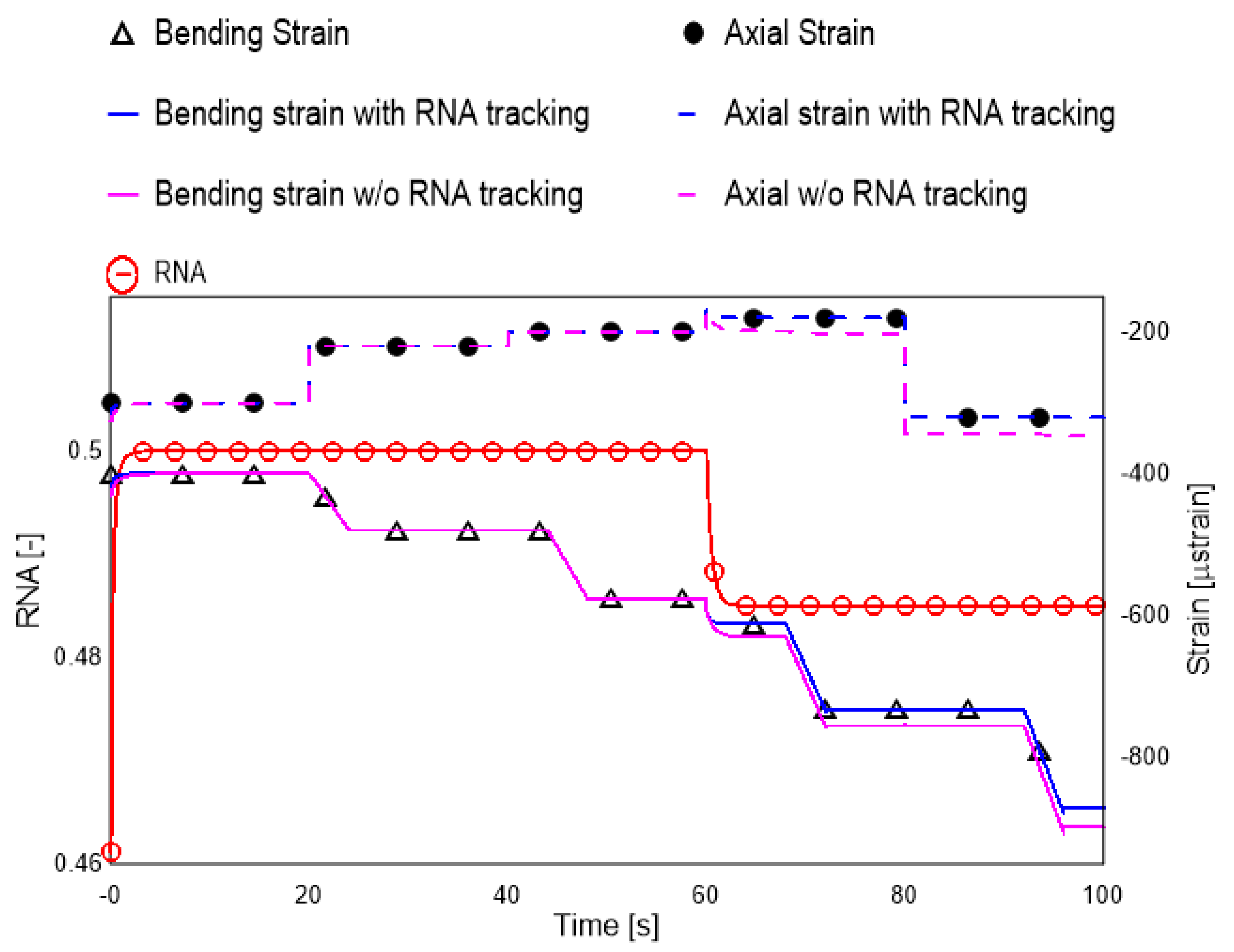
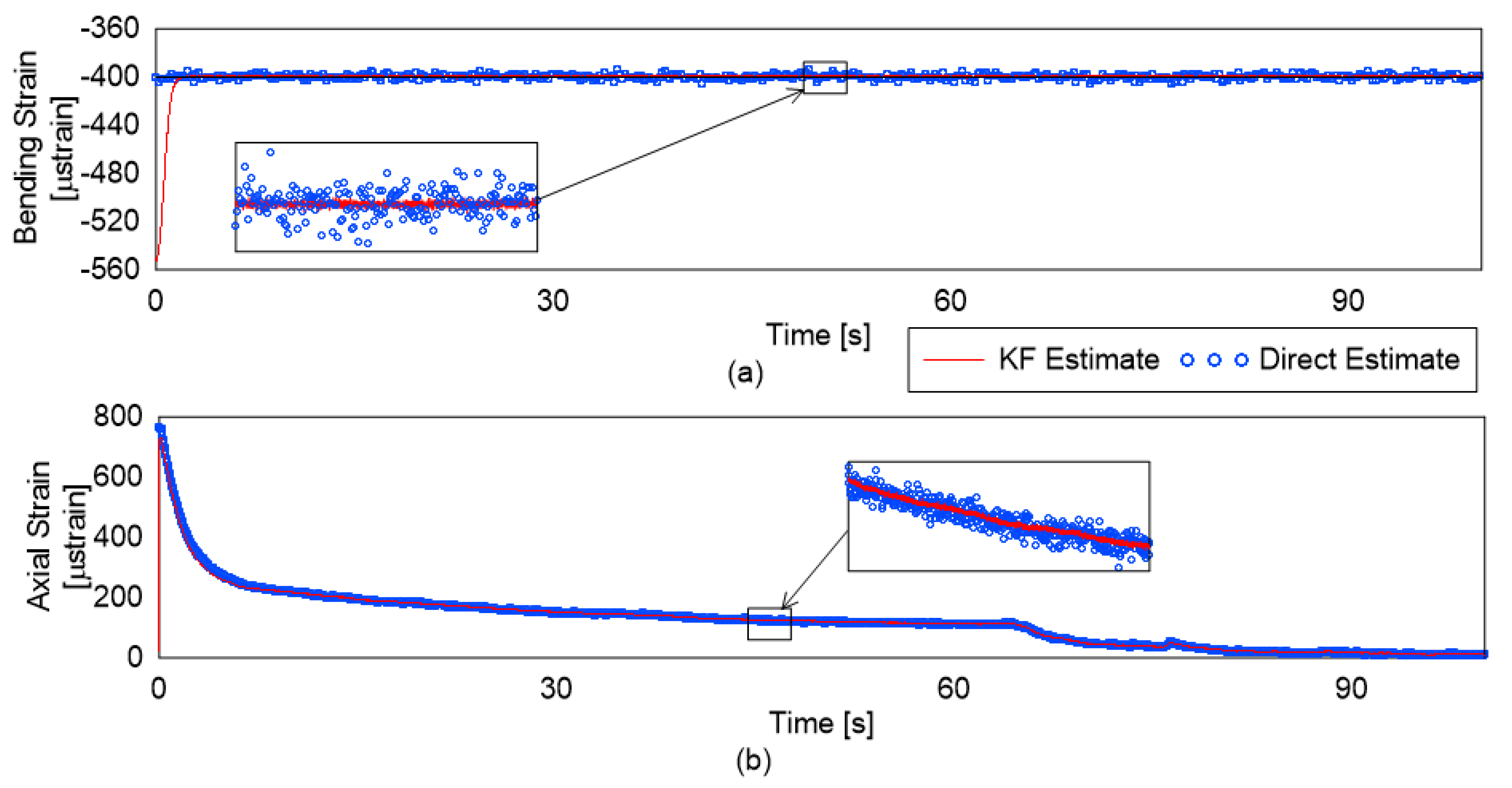
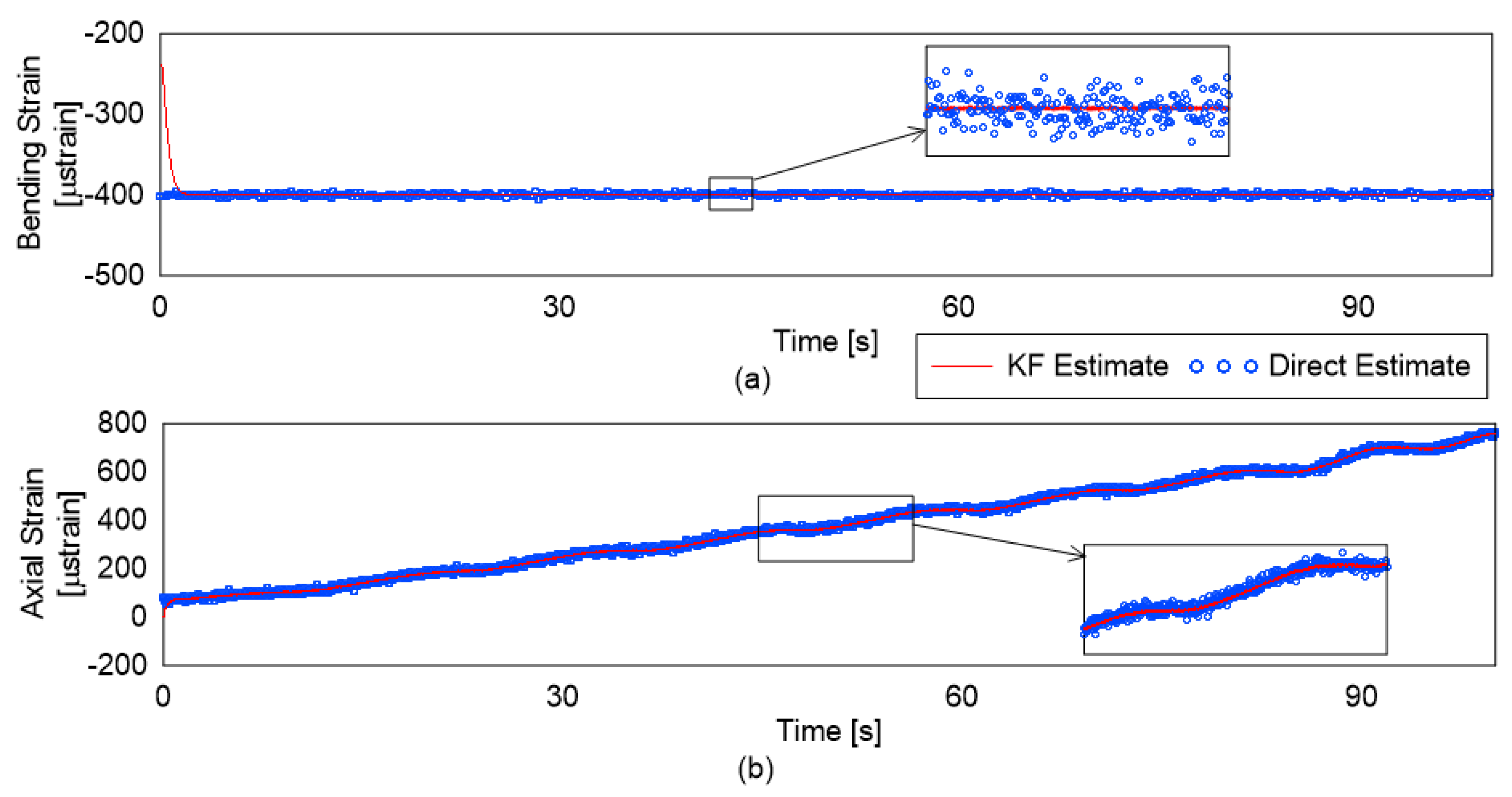
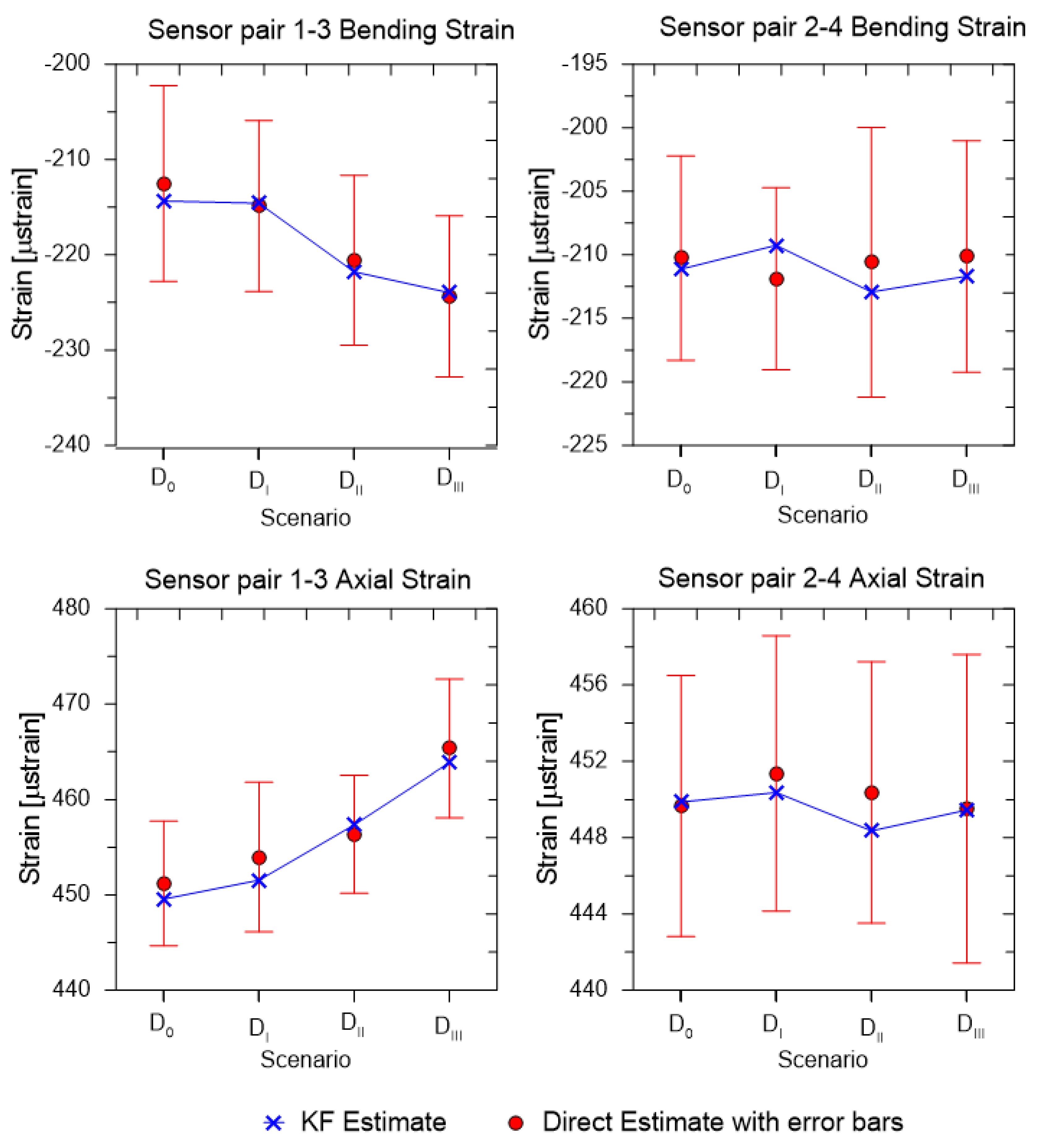
| Time [s] | True Strain [strain] | KF Mean (std) [strain] | DE Mean (std) [strain] |
|---|---|---|---|
| 0–20 | 369.2 | 369.2 (1.2) | 369.2 (1.3) |
| 24–44 | 443.0 | 443.0 (0.2) | 440.1 (1.3) |
| 48–68 | 531.7 | 531.7 (0.3) | 534.6 (1.3) |
| 72–92 | 636.9 | 636.9 (0.2) | 631.9 (1.3) |
| 96–100 | 756.9 | 756.9 (0.3) | 752.5 (1.2) |
| Time [s] | True Strain [strain] | KF Mean (std) [strain] | DE Mean (std) [strain] |
|---|---|---|---|
| 0–20 | 300.0 | 300.2 (0.8) | 304.5 (1.3) |
| 20–40 | 220.0 | 220.4 (0.4) | 225.3 (1.3) |
| 40–60 | 200.0 | 200.1 (0.6) | 197.7 (1.2) |
| 60–80 | 180.0 | 180.1 (0.5) | 182.6 (1.3) |
| 80–100 | 320.0 | 319.8 (0.6) | 315.9 (1.2) |
© 2018 by the authors. Licensee MDPI, Basel, Switzerland. This article is an open access article distributed under the terms and conditions of the Creative Commons Attribution (CC BY) license (http://creativecommons.org/licenses/by/4.0/).
Share and Cite
Soman, R.; Ostachowicz, W. Kalman Filter Based Load Monitoring in Beam Like Structures Using Fibre-Optic Strain Sensors. Sensors 2019, 19, 103. https://doi.org/10.3390/s19010103
Soman R, Ostachowicz W. Kalman Filter Based Load Monitoring in Beam Like Structures Using Fibre-Optic Strain Sensors. Sensors. 2019; 19(1):103. https://doi.org/10.3390/s19010103
Chicago/Turabian StyleSoman, Rohan, and Wieslaw Ostachowicz. 2019. "Kalman Filter Based Load Monitoring in Beam Like Structures Using Fibre-Optic Strain Sensors" Sensors 19, no. 1: 103. https://doi.org/10.3390/s19010103
APA StyleSoman, R., & Ostachowicz, W. (2019). Kalman Filter Based Load Monitoring in Beam Like Structures Using Fibre-Optic Strain Sensors. Sensors, 19(1), 103. https://doi.org/10.3390/s19010103






